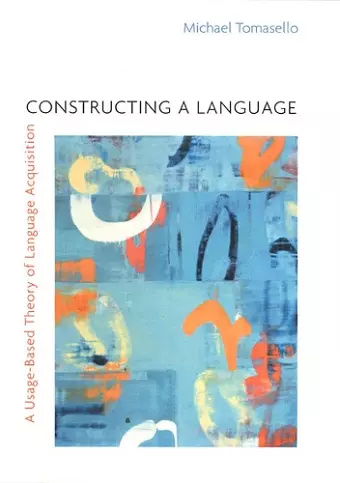Constructing a Language
A Usage-Based Theory of Language Acquisition
Format:Paperback
Publisher:Harvard University Press
Published:30th Apr '05
Currently unavailable, our supplier has not provided us a restock date

Constructing a Language is the best book on language development since Roger Brown's A First Language. Tomasello has taken full advantage of the research that has been done in the thirty years since Brown's landmark book, to give us a full account of language acquisition, from the first signs of intentional communication in prespeech through the most complex syntactic constructions children produce. The book rebuilds bridges between child language and linguistic theory -- but in place of generative grammar, Tomasello ties the study of emergent language to a usage-based approach derived from cognitive and functional linguistics. He is particularly persuasive in showing how it solves the essential problem of how children "get from here to there," as they move by analogy from item-based phrases and word islands to richer constructions. Tomasello's book presents a comprehensive and well-articulated theory of the language-learning process that is more complete and richer in its heuristic value than any other attempt of its kind. It will be difficult to refute and impossible to ignore. -- Elizabeth Bates, University of California at San Diego Certain to be a landmark in the language sciences, this book persuasively argues that all of our fundamental knowledge of language can be "learned" on the basis of what we hear, with recourse only to general basic cognitive abilities: intention reading and pattern-finding. No hard-wired "language instinct" is required. Tomasello's synthesis of linguistics and psychology will permanently change the debates about the developmental origins of language. -- Adele Goldberg, University of Illinois at Urbana-Champaign
Tomasello presents a comprehensive usage-based theory of language acquisition. Drawing together a vast body of empirical research in cognitive science, linguistics, and developmental psychology, Tomasello demonstrates children’s linguistic ability is interwoven with other cognitive abilities.
In this groundbreaking book, Michael Tomasello presents a comprehensive usage-based theory of language acquisition. Drawing together a vast body of empirical research in cognitive science, linguistics, and developmental psychology, Tomasello demonstrates that we don’t need a self-contained “language instinct” to explain how children learn language. Their linguistic ability is interwoven with other cognitive abilities.
Tomasello argues that the essence of language is its symbolic dimension, which rests on the uniquely human ability to comprehend intention. Grammar emerges as the speakers of a language create linguistic constructions out of recurring sequences of symbols; children pick up these patterns in the buzz of words they hear around them.
All theories of language acquisition assume these fundamental skills of intention-reading and pattern-finding. Some formal linguistic theories posit a second set of acquisition processes to connect somehow with an innate universal grammar. But these extra processes, Tomasello argues, are completely unnecessary—important to save a theory but not to explain the phenomenon.
For all its empirical weaknesses, Chomskian generative grammar has ruled the linguistic world for forty years. Constructing a Language offers a compellingly argued, psychologically sound new vision for the study of language acquisition.
Tomasello offers an extended and detailed exposition of his ‘usage-based’ theory of language acquisition, which he contrasts to nativist or ‘universal grammar’ theories such as those of Noam Chomsky and of Steven Pinker… Throughout this masterfully written but stylistically and intellectually dense book, Tomasello reports extensively on current research and looks critically at the assumptions and assertions of his contemporaries. -- L. Bebout * Choice *
Constructing a Language is the best book on language development since Roger Brown’s A First Language. Tomasello has taken full advantage of the research that has been done in the thirty years since Brown’s landmark book, to give us a full account of language acquisition, from the first signs of intentional communication in prespeech through the most complex syntactic constructions children produce. The book rebuilds bridges between child language and linguistic theory—but in place of generative grammar, Tomasello ties the study of emergent language to a usage-based approach derived from cognitive and functional linguistics. He is particularly persuasive in showing how it solves the essential problem of how children ‘get from here to there,’ as they move by analogy from item-based phrases and word islands to richer constructions. Tomasello’s book presents a comprehensive and well-articulated theory of the language-learning process that is more complete and richer in its heuristic value than any other attempt of its kind. It will be difficult to refute and impossible to ignore. -- Elizabeth Bates, University of California, San Diego
Certain to be a landmark in the language sciences, this book persuasively argues that all of our fundamental knowledge of language can be ‘learned’ on the basis of what we hear, with recourse only to general basic cognitive abilities: intention reading and pattern-finding. No hard-wired ‘language instinct’ is required. Tomasello’s synthesis of linguistics and psychology will permanently change the debates about the developmental origins of language. -- Adele Goldberg, University of Illinois at Urbana-Champaign
ISBN: 9780674017641
Dimensions: 224mm x 144mm x 25mm
Weight: unknown
408 pages